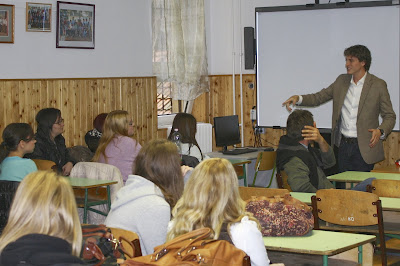Looking through a current U.S. passport you see a lot of pictures of amber waves of grain, purple mountains majesty, and yes of course some fruited plains. Most of the quotes that accompany these pictures speak to some combination of manifest destiny, nationalism, and freedom. One quote, though, speaks to the natural world that the first pilgrims likely encountered and on which they relied to survive and celebrate that first Thanksgiving. I'm not saying it's the most profound thing I've ever read about Thanksgiving, but I think it's worth sharing since it's the only quote in the passport that is about giving thanks and the only one to include the people who lived in the US before it was the US.
We send thanks to all the animal life in the world. They have many things to teach us as people. We are glad they are still here and we hope it will always be so. Excerpt from the Thanksgiving Address, Mohawk version
Today didn't feel like Thanksgiving until our group of 5 volunteers encountered an American who is studying in Wales and spending this week in Central Europe. He heard us speaking English as we boarded our train headed for Bratislava, Slovakia, and greeted us with, "Happy Thanksgiving!" It was a little bit of a gift that none of today's trains had wi-fi which left us with 6 hours of great scenery and conversation.
In Bratislava we were welcomed Miriam, Jeremy, Ursula, and Esme to begin our Thanksgiving weekend. Last Thanksgiving I never could have guessed that I'd be here in Bratislava celebrating with my new Central Europe family. And even though things haven't been smooth for all of us all of the time, there is a lot to be thankful for. Today presented many moments to be thankful, enjoy the ride, remember past feasts with friends and family (of course this includes the annual Augustana Thanksgiving Dinner), and look forward to Thanksgiving to come!
We send thanks to all the animal life in the world. They have many things to teach us as people. We are glad they are still here and we hope it will always be so. Excerpt from the Thanksgiving Address, Mohawk version
Today didn't feel like Thanksgiving until our group of 5 volunteers encountered an American who is studying in Wales and spending this week in Central Europe. He heard us speaking English as we boarded our train headed for Bratislava, Slovakia, and greeted us with, "Happy Thanksgiving!" It was a little bit of a gift that none of today's trains had wi-fi which left us with 6 hours of great scenery and conversation.
In Bratislava we were welcomed Miriam, Jeremy, Ursula, and Esme to begin our Thanksgiving weekend. Last Thanksgiving I never could have guessed that I'd be here in Bratislava celebrating with my new Central Europe family. And even though things haven't been smooth for all of us all of the time, there is a lot to be thankful for. Today presented many moments to be thankful, enjoy the ride, remember past feasts with friends and family (of course this includes the annual Augustana Thanksgiving Dinner), and look forward to Thanksgiving to come!










